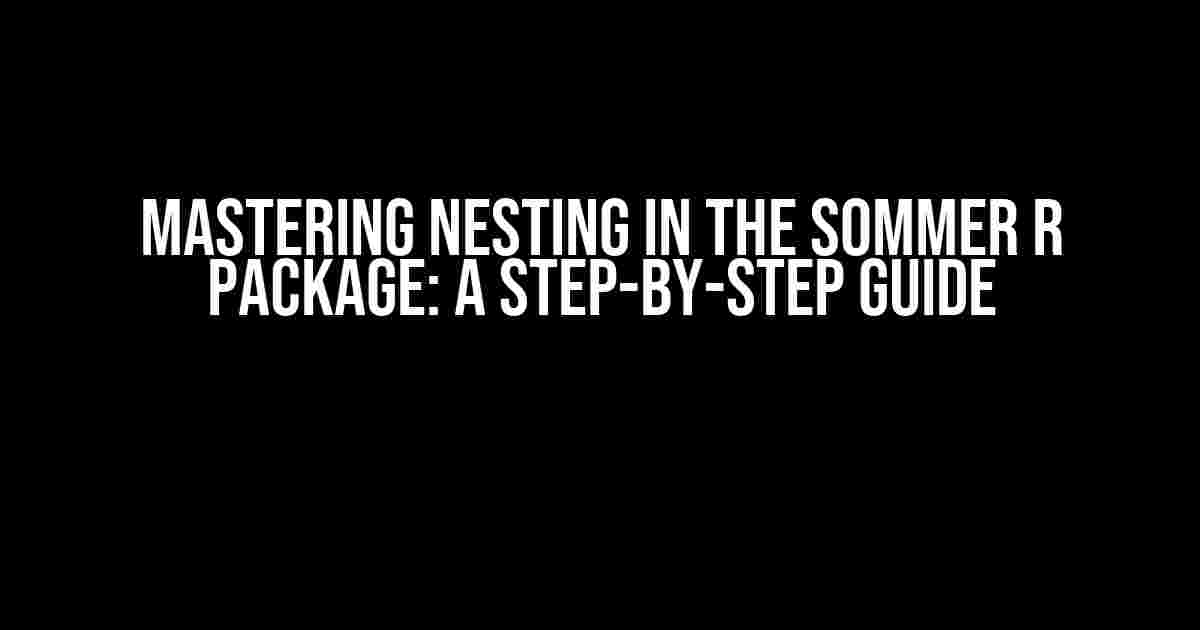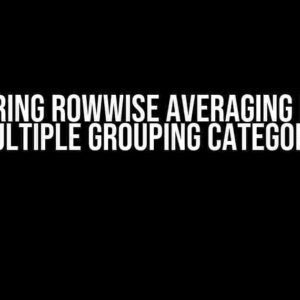Are you struggling to specify nesting correctly in the Sommer R package? Do you find yourself wrangling with nested models, only to end up with errors or incorrect results? Fear not, dear reader! In this comprehensive guide, we’ll dive into the world of nesting in Sommer, providing clear and concise instructions on how to get it right.
What is Nesting in Sommer?
Nesting in Sommer refers to the process of specifying hierarchical or clustered data structures in your models. This is particularly useful when working with data that has a natural hierarchy, such as students within classrooms, or patients within hospitals. By accounting for these groupings, you can more accurately estimate the effects of interest and reduce the risk of biased or misleading results.
The Basics of Nesting in Sommer
In Sommer, nesting is achieved using the nest() function, which allows you to specify one or more grouping variables. These variables define the hierarchical structure of your data, with each level representing a distinct grouping. For example, in a study examining the impact of teacher quality on student achievement, you might specify school and classroom as nesting variables, as students are nested within classrooms, which are in turn nested within schools.
library(sommer)
# Example data
df <- data.frame(
student_id = 1:100,
classroom_id = rep(1:10, each = 10),
school_id = rep(1:5, each = 20),
achievement = rnorm(100)
)
# Specify nesting
nesting <- nest(df, c(school_id, classroom_id))Types of Nesting in Sommer
Sommer supports two types of nesting: crossed and nested. Understanding the difference between these two is crucial for specifying your models correctly.
Crossed Nesting
In crossed nesting, each level of the grouping variable is unique and does not overlap with other levels. For example, in a study examining the effect of different exercise routines on weight loss, you might have participants nested within exercise routines, which are in turn crossed with different diets.
nesting <- nest(df, c(exercise_routine, diet))Nested Nesting
In nested nesting, each level of the grouping variable is a subset of the previous level. Using our previous example, students are nested within classrooms, which are in turn nested within schools.
nesting <- nest(df, c(school_id, classroom_id))Specifying Nesting in Sommer Models
Once you’ve specified your nesting structure, it’s time to incorporate it into your Sommer models. This can be done using the nest- argument in your model formula.
library(sommer)
# Fit a linear mixed effects model with nesting
fit <- sommer(achievement ~ 1 + (1|school_id/classroom_id), data = df)Fitting Different Types of Models
Sommer supports a range of model types, including linear mixed effects, generalized linear mixed effects, and Bayesian linear mixed effects models. The syntax for specifying nesting remains the same across models, making it easy to adapt your nesting structure to different modeling approaches.
# Fit a generalized linear mixed effects model
fit <- sommer(achieve_score ~ 1 + (1|school_id/classroom_id),
family = poisson(), data = df)
# Fit a Bayesian linear mixed effects model
fit <- sommer(achievement ~ 1 + (1|school_id/classroom_id),
prior = ~ normal(0, 1), data = df)Tips and Tricks for Working with Nesting in Sommer
Here are some additional tips and tricks for working with nesting in Sommer:
- Use meaningful variable names: This will make it easier to keep track of your nesting structure and ensure that your models are specified correctly.
- Verify your data structure: Before fitting your model, take the time to verify that your data is structured correctly and that your nesting variables are properly defined.
- Start with simple models: When working with complex nesting structures, it’s often helpful to start with simple models and gradually add complexity as needed.
- Use diagnostic plots: Sommer provides a range of diagnostic plots to help you evaluate the fit of your models. Use these to identify issues with your nesting structure or model specification.
Common Errors and Troubleshooting
Even with the best planning and preparation, errors can still occur when working with nesting in Sommer. Here are some common issues and troubleshooting tips:
- Error: “Invalid nesting structure.”: This error typically occurs when the nesting variables are not properly defined or when the data structure is incorrect. Check your data and verify that your nesting variables are correctly specified.
- Error: “Non-unique grouping variables.”: This error occurs when the grouping variables are not unique or when there are duplicate values. Ensure that your grouping variables are properly defined and that there are no duplicates in your data.
- : This warning occurs when the model is over-parameterized, leading to a singular fit. Try reducing the complexity of your model or adding additional data to improve the stability of the fit.
Conclusion
Mastering nesting in Sommer takes practice and patience, but with the right guidance and tools, you can unlock the full potential of your data. By following the steps outlined in this guide, you’ll be well on your way to specifying nesting correctly and producing accurate, reliable results. Remember to stay vigilant, verify your data structure, and use diagnostic plots to evaluate the fit of your models. Happy modeling!
| Keyword | Description |
|---|---|
| Nesting | Refers to the process of specifying hierarchical or clustered data structures in the Sommer R package. |
| nest() | A function in Sommer used to specify one or more grouping variables. |
| Crossed Nesting | A type of nesting where each level of the grouping variable is unique and does not overlap with other levels. |
| Nested Nesting | A type of nesting where each level of the grouping variable is a subset of the previous level. |
Keywords: Sommer, nesting, crossed nesting, nested nesting, linear mixed effects, generalized linear mixed effects, Bayesian linear mixed effects.
Frequently Asked Question
Need help with specifying nesting in the sommer R package? We’ve got you covered!
What is the basic syntax for specifying nesting in sommer?
The basic syntax for specifying nesting in sommer is `trait ~ env1/env2/env3 + (1|random1/random2/random3)`, where `env1`, `env2`, and `env3` are the fixed effects, and `random1`, `random2`, and `random3` are the random effects. This syntax tells sommer to estimate the variance components for each level of the nested structure.
How do I specify multiple levels of nesting in sommer?
To specify multiple levels of nesting, simply separate the random effects with a `/` character. For example, `(1|block/plot/subplot)` specifies three levels of nesting: block, plot, and subplot. Make sure to match the levels of nesting with the corresponding fixed effects in the model formula.
Can I specify correlated random effects in sommer?
Yes, you can specify correlated random effects by using the `||` character instead of `/`. For example, `(1|block||plot)` specifies a correlated random effect for block and plot. This is useful when the random effects are not independent, but rather have a covariance structure.
How do I specify nesting for multiple traits in sommer?
To specify nesting for multiple traits, use the `traits` argument in the `sommer` function and list the traits of interest. For example, `sommer(trait1 + trait2 ~ env1 + (1|random1/random2), data = mydata)` specifies a model with two traits and two levels of nesting.
What if I have unbalanced data, can I still use sommer?
Yes, sommer can handle unbalanced data. However, make sure to specify the nesting correctly, and sommer will take care of the rest. If you have any issues with convergence or singular fit, try using the `method` argument to specify a different optimization method, such as `method = “REML”`.



